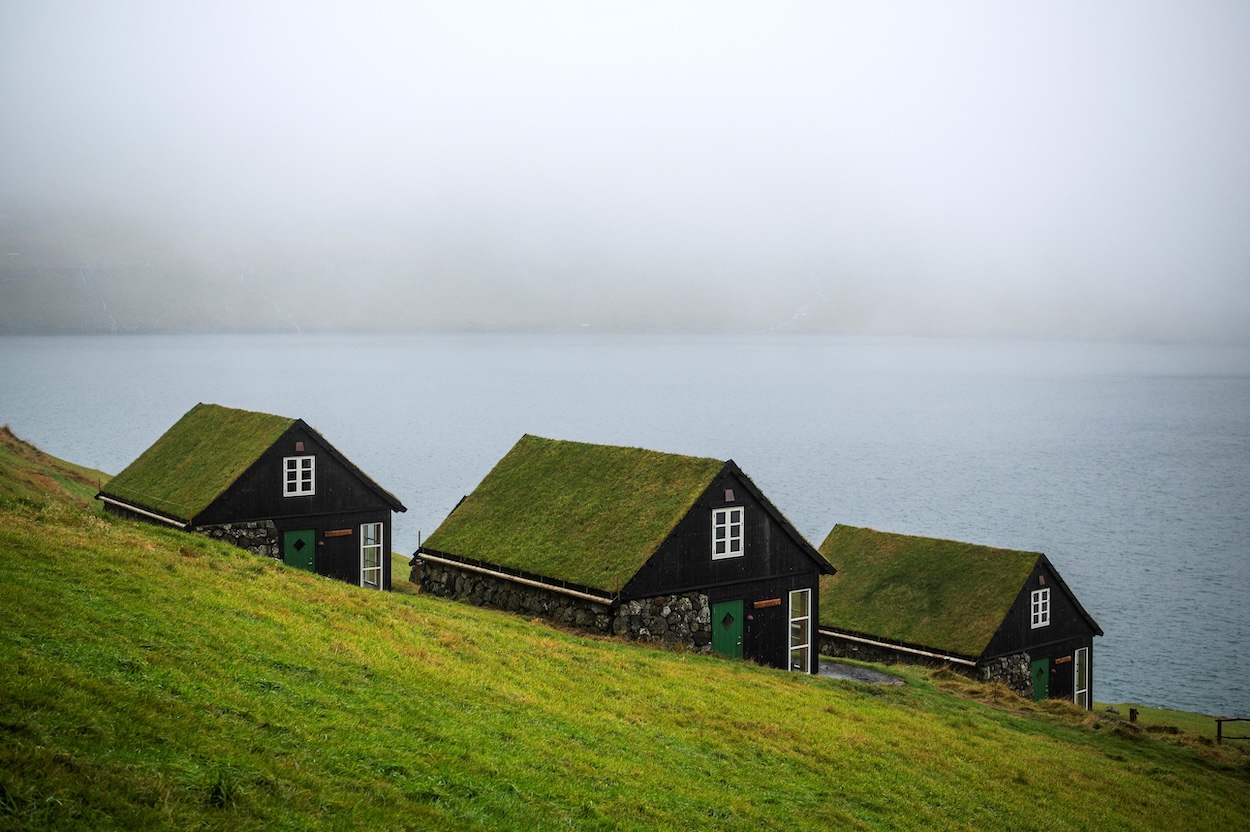I am five minutes out of the Faroe Islands’ windy, stomach-churning airport when the world twists into legend. It looks like Lord of the Rings but more menacing. Ten minutes later it’s a nightmare of single-track tunnels – go slooooow – carved into the earth by crazed dwarfs with too much time on their hands. Five minutes after that it’s Tolkien again, but redrafted by a boozed-up Norse god: dramatic buttes crumble into the Atlantic, mad farmers are ploughing near-vertical slopes, and waterfalls leap joyously from enormous cliffs to dissolve into lacy surf 300 yards below.
The land here feels tormented, as if the sky and the sea endured a bitter divorce and the cliffs are their broken children: jagged, furious and full of vengeance. For drama, it certainly beats the A1081 out of Luton Airport, even though that’s now been dualled.
To get to Tórshavn, the capital of this strange semi-independent country (halfway between Britain and Iceland, sort-of belonging to Denmark), takes another half-hour. But it’s worth the wait, as it’s a compelling mélange of chic Nordic modernism, oddly American suburbia and a historic core of wood and turf, cobbles and fishing nets: like a prehistoric Copenhagen translocated to the sub-Arctic. Here, in a whaleman’s cottage with a grass roof, I dine at Roks. It’s an ‘experimental’ restaurant – a phrase that often sends me fleeing. But then I start eating.
‘Sea urchin toast’ arrives: the dreamy, puréed orange gonads carefully piped onto a tiny brioche soaked in soy. It sounds appalling, like something dreamed up in a sadist’s lab, but it’s divine – better than anything I ate in a recent week in a posh part of France. Then I tuck into Greenlandic snow crab, drizzled with butter infused with burnt onion. It’s the Platonic ideal of crab.
The Faroes are not afraid of strong flavour – and somehow that matches the starkness of the landscape. One evening I join a ‘dine-with-locals’ supper in a rain-drenched village at the end of a fjord, ten miles north of Tórshavn. Andor the halibut fisherman is my host – a man who looks as though he could wrangle a shark with his bare hands – alongside Bjor, a yoga-teaching mandala painter. Together they pass beer, schnapps, potato soup, delicious salmon – and fermented sheep meat. It’s a local delicacy; it’s called ræst kjøt; it’s basically mutton left to rot politely in a shed for two months. You will never forget it, no matter how much you try.
Nor will you forget the driving. The Faroese have grown so rich on fish – some of these guys make £200,000 a year – they have bored extravagant tunnels everywhere, connecting nearly all the main islands. They will happily dig through entire mountains to ease access for a village of 30 souls. It makes for epic journeys anywhere, as you zip along frigid lakeshores and roar around treeless summits.
One day I speed north through these tunnels to Viðareiði, the most northerly village in the archipelago, which stares across the fjord at Enniberg, among the highest sea cliffs in the world. In past centuries, men risked their lives to climb down those vertical walls for seabird eggs. To steady themselves – or at least to ensure their corpses came home – they tied their ropes to gravestones from the village cemetery. If you fell into the roaring seas, your cadaver was safely tethered to the stone.
Nearby lies the ‘ghost village’ of Múli, half-abandoned but once home to a sorcerer named Guttormur í Múla. And also a witch, called Barbara við Kvíggja, who cursed fishermen by casting seashells into the fjord, each one a death sentence.
Supposedly, Guttormur and Babs went to war, armed with magic. But instead of a duel atop basalt crags, the climax is bizarrely domestic: he cut off her hair and locked her in a sauna. Yes, a sauna. Perhaps the private gym was closed. Apparently she survived, and spent the rest of her days muttering hexes about eternal bad weather. This may account for the Faroes’ Satanic climate. It rains so much here that when Icelanders were sent to the Faroes they regarded it, meteorologically, as a hardship posting.
It looks like Lord of the Rings but more menacing
Back at Tórshavn I catch a two-hour ferry to Suðuroy and motor to Akraberg, the southernmost point of the southernmost island. Tantalising archaeology suggests that Irish monks – the Papar – landed here and elsewhere in the Faroes, leaving behind place-names, peat mounds and perhaps some British-Irish genes in the Nordic locals. Standing on that cape, staring towards civilisation – so far to the south – you sense the yearning of the land and the people: a desire to be somewhere less bleak, somewhere that the sun might shine, a place where supper doesn’t involve the black skin of pilot whales (it tastes like a slice of patent-leather shoe).
Quite often it feels as if the winds and rain have scoured the Faroes of everything, including their history. But that’s not always the case. At Kirkjubøur, the seat of medieval bishops, I find Saint Olav’s ancient white church and the husk of Saint Magnus Cathedral, begun in the 13th century but abandoned amid famine, plague, Reformation. Right next door is Roykstovan – one of the world’s oldest inhabited wooden house, dating back 900 years.
Step inside on a misty day and it’s less a home than a pagan shrine, or the stage-set for a Norse version of The Texas Chainsaw Massacre: the walls are adorned with old weapons, rusty blades, obscure skulls, painted pillars, peculiar antlers, the smell of seal stew still lingering.
My time is nearly done, and my last day takes me to Trælanípa – the ‘slave cliff’ of Vágar. Here, the famous ‘floating lake’ of Sørvágsvatn perches improbably above the sea, spilling into a waterfall that seems to drain the sky. It was here, legend says, that Vikings hurled unwanted slaves – the old, the crippled, the annoying. If true, this was surely not a convenient disposal but a cruel pilgrimage: a place where murder was theatre and the Atlantic the final audience.
Standing at Trælanípa, battered by salt spray, I recall those first impressions, five minutes out of the airport: seeing this land torn between sea and sky. A visit to the Faroes is not so much a holiday as a vacation in myth – raw, brutal, unbearable, magnificent.
Atlantic Airways (atlanticairways.com) are now offering seasonal direct flights from London and Edinburgh to the Faroe Islands. For more information see visitfaroeislands.com.








Comments